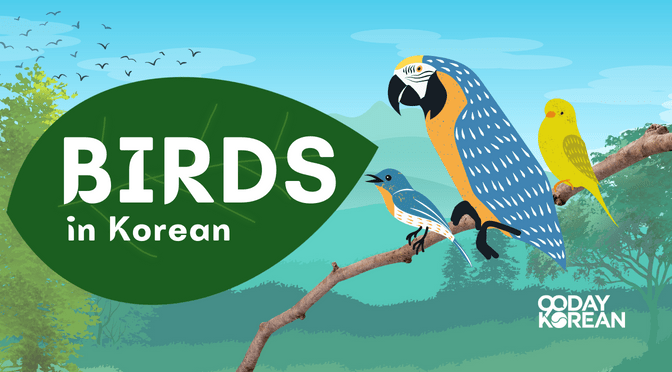This article will focus on different birds in Korean. Before, we learned the names of multiple animals in Korean, and now it’s time to focus on the birds’ translation specifically!
This vocabulary can be quite fun and useful to learn for daily life; for example, you may need to be able to know this when visiting the zoo. It’ll come especially handy if you want to go bird-watching.
If you love birds or wherever your interest lies, read on to learn the translation of bird names from English to Korean. Each vocabulary below will be written in Hangeul and romanized Korean, so it’s best to know the Korean alphabet beforehand.
Contents
- 1 “Bird” in Korean
- 2 Different names of birds in Korean
- 2.1 “Owl” in Korean
- 2.2 “Eagle” in Korean
- 2.3 “Ostrich” in Korean
- 2.4 “Turkey” in Korean
- 2.5 “Hawk” in Korean
- 2.6 “Seagull” in Korean
- 2.7 “Flamingo” in Korean
- 2.8 “Swan” in Korean
- 2.9 “Stork” in Korean
- 2.10 “Pigeon” in Korean
- 2.11 “Penguin” in Korean
- 2.12 “Goose” in Korean
- 2.13 “Parrot” in Korean
- 2.14 “Woodpecker” in Korean
- 3 Korean Birds
- 4 Wrap Up
“Bird” in Korean
The general word for “bird” in Korean is 새 (sae). You can use this when mentioning birds in general, especially in the case of birds you see on the streets, bushes, and trees in your everyday life, which you may not even know the name of. It can be a chicken, sparrow, peacock, or the birds that we will learn about below.
Different names of birds in Korean
We’ve listed some specific birds, from owls to woodpeckers, and what they are called in the Korean language.
| English | Korean |
|---|---|
| Bird | 새 (sae) |
| Bittern | 알락해오라기 (allakaeoragi) |
| Canary | 카나리아 (kanaria) |
| Chicken | 닭 (dak) |
| Cock | 수탉 (sutak) |
| Cockatoo | 앵무새 (aengmusae) |
| Crane | 두루미 (durumi) 학 (hak) |
| Crow | 까마귀 (kkamagwi) |
| Cuckoo | 뻐꾸기 (ppeokkugi) |
| Cygnet | 새끼 백조 (saekki baekjo) |
| Dove | 비둘기 (bidulgi) |
| Drake | 수오리 (suori) |
| Duck | 오리 (ori) |
| Duckling | 새끼 오리 (saekki ori) |
| Eagle | 독수리 (doksuri) |
| Feather | 깃 (git) 깃털 (gitteol) |
| Flamingo | 홍학 (honghak) |
| Gadwall | 알락오리 (allagori) |
| Goose | 거위 (geowi) |
| Hawk | 매 (mae) |
| Hen | 암탉 (amtak) |
| Heron | 왜가리 (waegari) |
| Hummingbird | 벌새 (beolsae) |
| Jay | 어치 (eochi) |
| Kingfisher | 물총새 (mulchongsae) |
| Kite | 솔개 (solgae) |
| Lark | 종달새 (jongdalsae) 종다리 (jongdari) |
| Macaw | 마코앵무새 (makoaengmusae) |
| Magpie | 까치 (kkachi) |
| Mynah | 구관조 (gugwanjo) |
| Nightingale | 나이팅게일 (naitinggeil) |
| Ostrich | 타조 (tajo) |
| Owl | 올빼미 (olppaemi) 부엉이 (bueongi) |
| Parrot | 앵무새 (aengmusae) |
| Partridge | 자고새 (jagosae) |
| Peacock | 공작 (gongjak) |
| Peahen | 공작 (gongjak) |
| Pelican | 펠리컨 (pellikeon) |
| Penguin | 펭귄 (penggwin) |
| Pigeon | 비둘기 (bidulgi) |
| Quail | 메추라기 (mechuragi) |
| Raven | 까마귀 (kkamagwi) |
| Robin | 울새 (ulsae) |
| Rook | 떼까마귀 (ttekkamagwi) |
| Rooster | 수탉 (sutak) |
| Skylark | 종달새 (jongdalsae) |
| Sparrow | 참새 (chamsae) |
| Stork | 황새 (hwangsae) |
| Swan | 백조 (baekjo) |
| Toucan | 큰부리새 (keunburisae) |
| Turkey | 칠면조 (chilmyeonjo) |
| Vulture | 독수리 (doksuri) |
| Weaver Bird | 멋장이새 meotjangisae |
| Woodpecker | 딱따구리 (ttagttaguri) |
“Owl” in Korean
The word for “owl” in Korean is 올빼미 (olppaemi). Although their facial appearance may change depending on which owl species is in question, their features are always recognizable, and their coloring earthly. You can find owls basically anywhere in the world.
올빼미의 울음 소리가 들리는 것 같아. (olppaemiui ureum soriga deullineun geot gata.)
I think I can hear owls crying.
“Eagle” in Korean
The word for “eagle” in Korean is 독수리 (doksuri). These majestic-looking animals come with sharp claws and beaks, with their coloring ranging mostly from black to brown. Similar to owls, eagles are also distributed all around the world.
독수리가 긴 날개를 펴고 날아올랐어요. (doksuriga gin nalgaereul pyeogo naraollasseoyo.)
The eagle spread its long wings and flew up.
“Ostrich” in Korean
The word for “ostrich” in the Korean language is 타조 (tajo). There are only two species of this huge bird that cannot fly. Today,they are native to basically only Africa. However, it is also possible to see ostriches in person on South Korea’s Nami Island.
타조는 날지 못하지만 빨리 달릴 수 있습니다. (tajoneun nalji motajiman ppalli dallil su itseumnida.)
Ostriches can’t fly, but they can run fast.
“Turkey” in Korean
The word for “turkey” in Korean is 칠면조 (chilmyeonjo). These large birds with red and blue details on their face are native to North America. However, you can also find turkey species in Mexico’s Yucatán Peninsula. They enjoy life in foresty areas.
저희는 크리스마스에 칠면조 요리를 먹었어요. (jeohineun keuriseumaseue chilmyeonjo yorireul meogeosseoyo.)
We ate turkey on Christmas.
“Hawk” in Korean
The word for “hawk” in Korean is 매 (mae). With an appearance somewhat similar to eagles, hawks also belong to the family of birds of prey. They are not quite as widely distributed worldwide as eagles, with many of them most commonly found in North America and nearby territories.
옛날에는 매를 훈련시켜 꿩이나 토끼를 사냥하기도 했어요. (yennareneun maereul hullyeonsikyeo kkwongina tokkireul sanyanghagido haesseoyo.)
In the past, they used to train hawks to hunt pheasants and rabbits.
“Seagull” in Korean
The word for “seagull” in the Korean language is 갈매기 (galmaegi). Typically, they are mostly white, with some grey and black features. You also must have heard a seagull wail at least once in your life. Gulls are found anywhere in the world, even including Antarctica.
저기 갈매기 한 무리가 지나가요. (jeogi galmaegi han muriga jinagayo.)
There’s a group of seagulls passing by.
“Flamingo” in Korean
The word for “flamingo” in Korean is 홍학 (honghak). These unique pink birds with long and slim legs can be found in parts of Africa and South America, as well as the Caribbean islands and nearby areas, in the case of the American flamingo.
홍학은 색이 화려해서 정말 멋져요. (honghageun saegi hwaryeohaeseo jeongmal meotjyeoyo.)
Flamingos are really cool because they are colorful.
“Swan” in Korean
The word for “swan” in Korean is 백조 (baekjo). Swans are beautiful and majestic water birds mostly found in the Northern Hemisphere. Most of the swan species are of migratory nature.
저 백조들을 좀 봐요. (jeo baekjodeureul jom bwayo.)
Look at those swans.
“Stork” in Korean
The word for “stork” in Korean is 황새 (hwangsae). Just like flamingoes, storks also have long and slim legs, although they do also fly and soar to some extent. A stork species can be found nearly everywhere in the world except for the poles.
둥지를 떠난 황새가 다시 돌아왔어요. (dungjireul tteonan hwangsaega dasi dorawasseoyo.)
The stork that left the nest is back.
“Pigeon” in Korean
The word for “pigeon” in Korean is 비둘기 (bidulgi). These birds are slightly smaller than seagulls and come in various colors. You can find them nearly anywhere except the deserts and Arctic areas.
공원에서 비둘기를 쉽게 볼 수 있어요. (gongwoneseo bidulgireul swipge bol su isseoyo.)
You can easily see pigeons in the park.
“Penguin” in Korean
The word for “penguin” in Korean is 펭귄 (penggwin). These absolutely adorable black and white birds are also the type that cannot fly. Besides Antarctica, penguins also live on the Galapagos Islands and South Africa, among other similar locations.
펭귄이 수영하는 것을 본 적이 있어요? (penggwini suyeonghaneun geoseul bon jeogi isseoyo?)
Have you ever seen a penguin swim?
“Goose” in Korean
The word for “goose” in Korean is 거위 (geowi). Geese are water birds of the larger end, and they are of migratory nature. They come in different colors, such as mixes of brown, black, and white.
이웃이 거위 한 마리를 키우겠냐고 했어요. (iusi geowi han marireul kiugennyago haesseoyo.)
My neighbor asked me if I would keep a goose.
“Parrot” in Korean
The word for “parrot” in Korean is 앵무새 (aengmusae). Parrots are some of the most colorful birds in the world. You can find them in the tropical and subtropical parts of the world.
너는 앵무새처럼 흉내를 잘 내는구나. (neoneun aengmusaecheoreom hyungnaereul jal naeneunguna.)
You’re good at mimicking like a parrot.
“Woodpecker” in Korean
The word for “woodpecker” in Korean is 딱따구리 (ttakttaguri). These small birds are known for the red tufted feathers on their crown, and the tapping sounds they make on trees. Besides Antarctica, Australia, and its nearby regions, you can come across a woodpecker just about anywhere.
딱따구리는 나무 속 벌레들을 잡아먹습니다. (ttakttagurineun namu sok beolledeureul jabameokseumnida.)
Woodpeckers eat bugs in trees.
Korean Birds
Sadly, not all of the birds mentioned above can be found in South Korea. And some of them you may only be able to see in zoos. However, South Korea does have its own diverse selection of birds, which will be a delight for you to see in the wild.
For example, South Korea has numerous different goose species, although the majority of them are quite rare to get a sighting of. On the other hand, swans, shelducks, and grebes are far more common to come across nearby water.
As far as species of pigeons and doves go, only the Oriental turtle dove appears to be commonly present in South Korea. Others are either not endemic to the nation or are rare sightings.
You will also likely see some type of cuckoo bird on a stroll in foresty areas at some point, as well as cormorants. Numerous gull species are, of course, common sightings in different parts of South Korea. On a good day, you’ll also be able to spot a hawk or an eagle flying around in the sky.
There are also some owls endemic to Korea, of which you are most likely to see the small and yellow-eyed Oriental Scops-Owl, the large and ear tuft-holding Eurasian Eagle-Owl, and the beautiful brown and white-colored Northern Boobook.
In addition to these few Korean birds we have named, there are numerous other bird species present in South Korea, both large and small. A particularly famous one among them is the Magpie, which has earned its status as Korea’s National Bird.
Korean National Bird
As we briefly just mentioned, the national bird of South Korea is Magpie. The word for “magpie” in the Korean language is 까치 (kkachi). This beautiful, relatively small bird belongs to the Corvidae family. Among magpies, there are multiple different species, many of them sporting a black-and-white coloring, while others are blue and green.
In South Korea, it is the Oriental Magpie that is especially common to see around. This mostly black and white bird, sometimes seen with hues of purple, dark green, or dark blue, is often even referred to as Korean Magpie.
Wrap Up
And now you know so much more about the words related to birds in Korean! In addition, you have also learned more about each bird and what kinds of birds you can find in Korea. Wow, did we just hit three birds with one stone, so to speak?
If you still have time to learn Korean, how about learning the different colors in Korean next? This way, you’ll also identify the birds based on their colors in the Korean language!
Leave us a comment below on what your favorite bird is!







